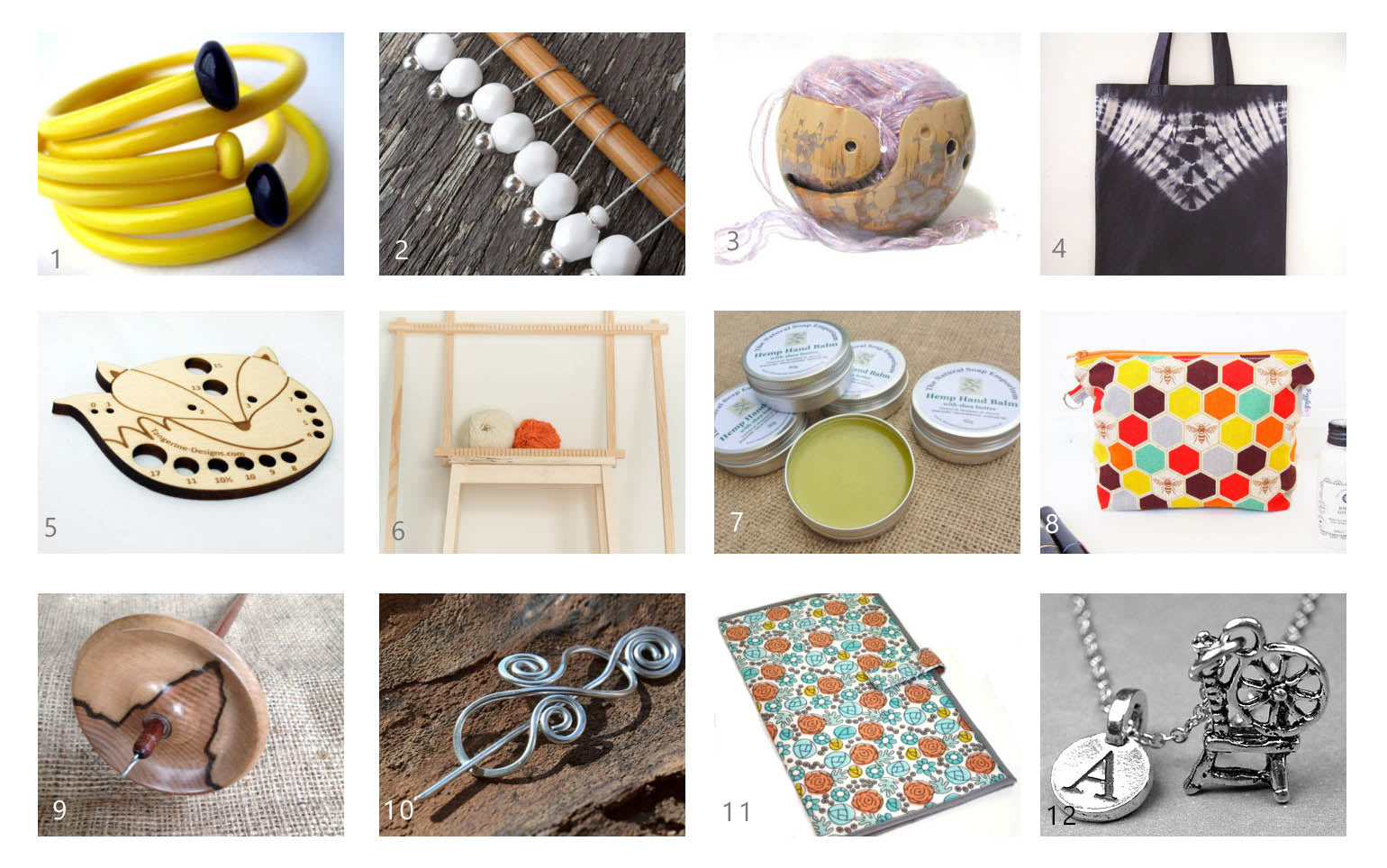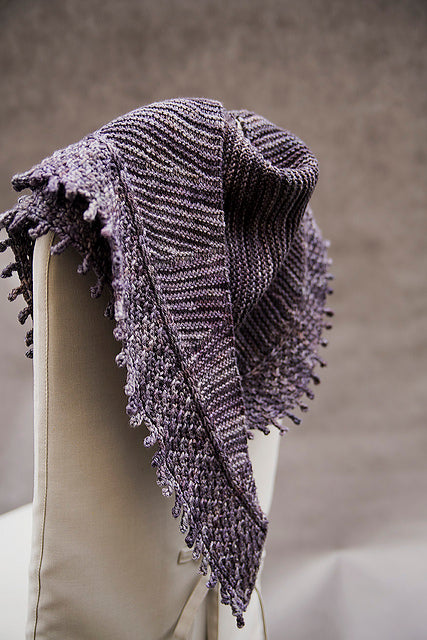News
Gifts for Fibre Lovers
This year I've had a wonderful time searching for artisan made gifts both online and locally. Not only do I believe that it's important to support small, artisan businesses, I also believe that these hand crafted items make wonderful unique gifts. So, with Christmas just around the corner, here's a selection of some of my favorite gift ideas (sourced through Etsy) that I'm sure most fibre enthusiasts would love.

1. Recycled Vintage Knitting Needle Bracelet by Sewnewthings
2. Stitch Markers by Chaton Designs
3. Knitting Bowl by Sunbird Pottery
4. Shibori Dyed Project Bag by Kimi Silks
5. Fox Needle Gauge by Tangerine Designs
6. Weaving Loom Starter Kit by Loom and Spindle Australia
7. Organic Hemp Hand Balm with Beeswax and Essential Oils by Natural Soap Emporium
8. Makeup Pouch (or notions bag for crafters!) by Piggledee
9. Blackheart Sassafras and Blackwood Drop Spindle by Luxury Overdose
10.Celtic Wire Shawl Pin by Rebbeltjes Touch
11.Pattern Wallet by H+T Studios
12. Spinning Wheel Necklace with Personalised Monogram Letter by Chrys Designs Jewelry
Feel free to post your own suggestions below, I would love to be enabled ;)
xx
Incentive

This week we are thrilled to reveal yet another wonderful collaboration. We have teamed up with Polish designer Hanna Maciejewska, who has turned two skeins of our DK yarn into a beautiful shawl design called 'Incentive'.

Incentive is the perfect accessory for cold winter days: it's large enough to wrap around, keeping you warm and cozy and the crescent shape is easy to style and will stay put around your shoulders. As you can see in the picture above, Hanna has used two different stitch patterns on the body and edging of the shawl, adding a pleasing 'visual' texture which is topped off beautifully with the picot edging.

The beautiful textual design of this shawl calls for a subtle semi-solid or tonal colourway (Hannah used the tonal colourway Storm). Below are some of my colourway picks:
Incentive is now available over on Ravelry. You can see more of Hanna's designs here and check out her inspiring blog 'Life Is A Stitch'.
Giveaway!
Thanks to Hanna, I will be giving away a pattern as well as two skeins of Skein DK to make the Incentive shawl (winner's choice of colour) to one lucky reader/podcast viewer! All you have to do is tell us in the comments below which Skein colour you would choose to make this beautiful shawl. Entries close on December 8th; the winner will be chosen using a random number generator and announced on the blog. Entry is limited to one post per person.
Have a wonderful week!
xx
Shawl pictures courtesy of Daniel Maciejewski
Sale!

28th & 29th Nov - 20% off sale
From Friday 28th until the end of Saturday 29th of November (AEST), we will be offering 20% off all items on our website. This includes pre-orders for 30 of our speckle-dyed colourways on your choice of yarn base (see preview here)! Just use the code SALE2014 when checking out.
This will be the last sale for some time, so don’t miss out!
Hope to see you there!
xx
NB:If you’re looking to purchase some speckle-dyed colours, they will be located on the update page during the sale.
Clairière

In collaboration with Swedish designer Anna Martina, of Playsweetmusic, we are very proud to present Clairière, a beautiful two-colour shawl knit using Skein Merino Cashmere Fingering. Anna drew inspiration for this design from the Swedish forest, wanting to 'illustrate the sun glittering through the holes in the leaf covered ceiling'.

Clairière is a triangular shaped shawl knit from the top down, which can be easily sized to suit personal preferences. It's great if you want to use up every last bit of your yarn! Sample is shown in colourways Gingko, for the main body, and Fallow, for the edging. With a two-colour shawl like this, it's fun to play around with colour combinations. Below are some of my favorites:
Clairière is now available over on Ravelry, as well as on the Playsweetmusic blog. You can see more of Anna's designs here.
Giveaway!
Thanks to Anna, I will be giving away a pattern as well as two skeins of Skein Merino Cashmere Fingering to make the Clairière shawl (winner's choice of colour) to one lucky reader/podcast viewer! All you have to do is tell us in the comments below which two Skein colours you would choose to make this beautiful shawl! Entries close on December 8th; the winner will be chosen using a random number generator and will be announced on the blog. Entry is limited to one post per person, please.
Have a wonderful weekend!
xx
Shawl pictures courtesy of Anna Martina
New Shipping Rates!

Shipping rates reduced by 50% for international orders and 25% for domestic!
We have in the past received a significant amount of customer feedback about the high cost of shipping overseas from Australia. We are accordingly happy to announce that, on account of successfully negotiating a better deal with Australia Post, we are now able to offer half-price international shipping (Air Mail only) on all orders! For example, if you’re in the USA and you order up to four skeins of yarn, shipping will now cost $7.05AUD (around $6 USD) instead of $14.10. Similarly, shipping to the UK for the same amount will now cost $9.10 (around $5 GBP) instead of $18.20. So, no matter where in the world you live or how much you buy, shipping is now half price. This means huge savings and, hopefully, international customers who have been previously put off from buying from us due to the postage cost, will now be able to do so.
Australians need not feel left out, for we’re equally happy to announce that parcels shipped to all states and territories have been reduced by 25%!
Great news and just in time for Christmas!
xx
Colour Palette of the Week: Coffee

I used to be a tea drinker, but over the past few years I have turned to the dark side preferring coffee over tea any day. A well made coffee with lots of creme and smooth, frothy milk is the bomb. The little hand woven placement in the picture above was bought overseas in Cyprus which, as in Greece serves the best iced coffee, called Frappé, made with condensed milk, milk and ice cubes. Sounds rather gross but it is soooo good, wish I had one right now!
Colour Palette of the Week: Bouquet

I love freshly cut flowers and, now that spring is here, my house and even the dye studio is adorned with vases of bright, cheery colour. So this weeks colour palette is inspired by the floral bouquets that add colour and happiness to my surroundings.
What's inspiring you?
xx
# skeinyarn
Over the years I have found that there is nothing more fulfilling than seeing our yarn and fibre, photographed by customers, either as stash pictures, WIPs or finished objects. So, it's wonderful to be able to add an Instagram feed to our website which will allow you to share your Skein pictures with us and the rest of the Skein community! #skeinyarn will update daily with new pictures that have been tagged with this hashtag, so start tagging!
xx
Colour Palette of the Week - Coastal

Every week I post a 'Colour Palette of the Week' on the shop. I thought it would be interesting if, every week, I share the inspiration behind these colour combinations. So this week's inspiration is the beach!

Our local beach is surrounded by a national park which is rugged, beautiful and full of Banksia trees. There is a paved walking track that takes you all along the headland and down to the beach. Most days you will see wallabies and kangaroos and, if you're very lucky, dolphins or whales (and sometimes snakes if unlucky!). Last weekend I collected a few things during our walk and these items are the inspiration behind this week's 'Coastal' colour palette.

Banksia husks, purple shells, banksia leaves, coastal wild flowers and pebbles collected from the beach.
Hope you had a wonderful weekend!
xx
Weekend Knitting
Its now Friday afternoon and I'm just about to lock up the studio for the long weekend - just one last picture before I go. This is my currant WIP, Japan Sleeves by Joji Locatelli. I'm using Skein, Merino Cashmere Fingering in the Rye and Tickled Pink colours - so looking forward to working on this while relaxing in the sun and listening to a podcast or two over the long weekend.
Have a great weekend and if you live in NSW happy long weekend!
xx
Perfect!

A few months ago, I created our newest colourways called 'speckle dyed'. I was very interested to see how these colours would knit up, so I took two skeins of the colourway 'Neon and Grey' off the shop and, at the very same time, spotted a new shawl design called Dotted Rays by Stephen West - perfect! I immediately cast on and over the course of the next few months, knitted happily away on this project. There's lots of short rows, comforting garter stitch and an easy to remember pattern - the perfect equation for chilled-out couch knitting. I have said this before but the speckled yarn is a delight to knit with: each stitch knits up into a new colour, which creates a knitted fabric that is lightly sprinkled with bright pops of colour; it's fun to watch which colour will appear next. As you can tell I had a lot of fun knitting this shawl, so much so that I'm almost sad to say that I have now finished. Almost sad, but very happy to have a wonderful new shawl to wear.



Pattern: Dotted Rays by Steven West
Yarn: Skein - Merino Cashmere Fingering in the colourway 'Neon and Grey' (two skeins)
Needle Size: 4mm/US6
Pattern notes: See here
Happy creating!
xx
New Colourways!

A few months ago I noticed that our semi-solid range of colourways was lacking in variety, so I set about filling in the gaps in hopes of offering you guys a nice palette of colour to choose from. This task was both challenging and a lot of fun, I don't know how many shade cards and websites I viewed for inspiration, but I think I nailed it! Last week I introduced these 34 new colourways to the shop, and the feedback that I received made all the hard work worth while.

I'm totally smitten with all of these colours, I can tell you it was VERY hard not to pinch a few off the store for myself.
The new colourways are now available to custom order, as always if you have any questions or need help in selecting the perfect colour combination, feel free to contact me!
Happy creating!
xx























